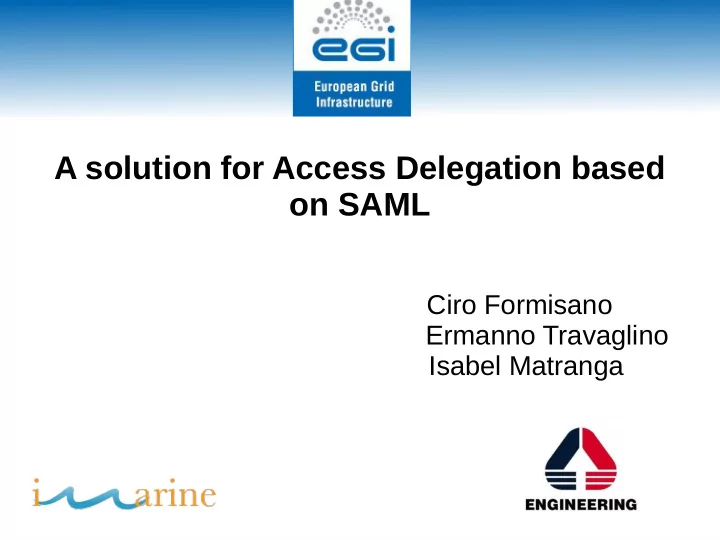

A solution for Access Delegation based on SAML Ciro Formisano Ermanno Travaglino Isabel Matranga
Access Delegation in distributed environments SAML 2.0 Condition to Delegate Implementation Future plans
Access Delegation in distributed environments SAML 2.0 Condition to Delegate Implementation Future plans
Access Delegation Access Delegation is the process by which an entity provides ● another entity with a subset of its privileges ○ Who provides the privileges is the delegator ○ Who is provided with the privileges is the delegate ○ Delegation is recursive: i.e. a delegate can provide another delegate with a subset of his/her/its privileges Delegator and delegate can be users or processes ● ○ In most cases the first delegator is a human user (but it is not mandatory) Delegator and delegate must be known by the involved identity ● domain(s) Delegation is time limited ●
Use cases ● The delegate is a user ○ Someone provides someone with a power of attorney for some private affairs ○ The boss enables an employer to access certain data on his behalf ● The delegate is a process ○ A batch grid job started by a process authenticated by a proxy certificate ○ A Facebook user enables an application to access some data with his/her privileges
Delegation in a Cloud Federation ● The User has identities on the two Clouds (User@Cloud1 and User@Cloud2 who owns R1) ● Cloud 2 trusts Cloud 1 through its credentials (e.g. X509) ● User@Cloud2 delegates Cloud 1 to manage R1 ● From this moment User@Cloud1 can safely manage his/her objects on Cloud 2 as they were on a single cloud ● Behind the scene Cloud 1, if needed, accesses Cloud 2 to manage data on behalf of User
Basic information to delegate ● The basic information needed for a delegation process, is: ○ The delegation actors (involved delegators, delegates, actions, roles and resources) ○ Delegation expiring time ● These pieces of information must be checked by the Identity and Access Management System: ○ The delegation is not expired ○ The caller must be be authenticated (through his/her/its credentials) and his/her identity must match with the identifier of the delegate ○ The delegator is associated with the delegated roles and actions on delegated resources and is able to delegate them
Access Delegation in distributed environments SAML 2.0 Condition to Delegate Implementation Future plans
SAML 2.0 Condition to Delegate ● OASIS Specification fully compliant with SAML 2.0 ○ defines DelegationRestrictionType, a subtype of Condition containing a sequence of Delegate elements defining the delegation chain ○ The Delegate element includes attributes defining the delegation instant and the confirmation method ○ The identifier of the delegate is included in a child element of Delegate ● The produced Token is a valid SAML 2.0 Assertion ○ Contains all the mandatory elements ○ The Condition element of DelegationRestrictionType is ignored by Service Providers not compliant with the specification
Access Delegation in distributed environments SAML 2.0 Condition to Delegate Implementation Future plans
Complete Information set for delegation ● SAML 2.0 Condition to Delegate specification defines two pieces of information: ○ Delegation chain ○ Delegation instant ● A basic delegation process need further pieces of information, specified in the rest of the Assertion, in particular: ○ The Assertion subject defines the last delegator (also present in the chain) ○ Assertion attributes define delegated actions, roles and resources ○ NotOnOrAfter and NotBefore elements define the Assertion lifetime
Use Case: data federation on a inter-cloud Resources inside the federation should be accessed regardless their actual location ● A process called Federator dispatches every user request to the cloud where resources are ● The Federator Process is delegated by every user of the Cloud to access their data in the Federation
Resource Federation Process (1) ● The two clouds must trust each other ● User 1 owns an identity on Cloud 1 and an identity on Cloud 2 ● The Federator owns an identity on Cloud 2 ● User 1 provides the Federator with a delegation id to access his/her data on Cloud 2
Resource Federation Process (2) ● User 1 logs into Cloud 1 to request Data ● Cloud 1 discovers that requested data are on Cloud 2 and asks the Federator to retrieve them ● The Federator uses the delegation id to get the data with its identity
Developed components ● Shibboleth provides a plugin compliant with SAML 2.0 Condition to delegate ● Shibboleth plugin is limited to uPortal use case ● Shibboleth plugin does not enable direct Token management ● Implemented an extension to Shibboleth Service Provider and Identity Provider ● Manages SAML Token Profile ● Provides SAML 2.0 Condition to delegate at Token level
Access Delegation in distributed environments SAML 2.0 Condition to Delegate Implementation Future plans
Future plans Access Delegation Mechanisms will be part of a Federated Identity and Access Management Framework ● SAML Identity Federation will be integrated with SAML Delegation – SAML Identity Federation Module provides Shibboleth based web browser SSO and web services federation – will enable delegated access with identities valid in the whole Federation (no user1@Cloud1 and user1@Cloud2) ● A complete XACML based Federated Authorization framework – Multi-layer authorization, enabling to define and enforce attribute based authorization policies at federation layer and domain layer
Kiitos! Ciro Formisano <ciro.formisano@eng.it>
Recommend
More recommend